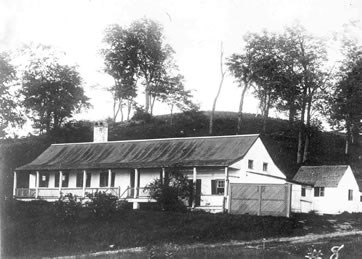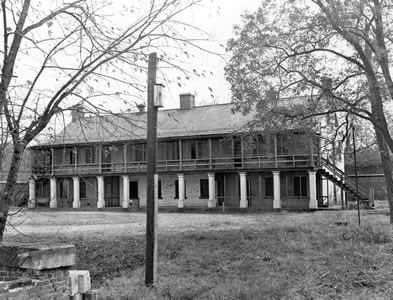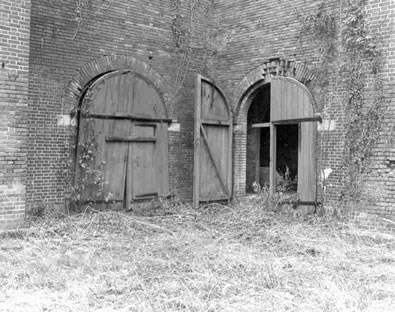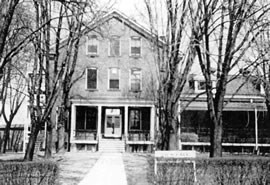
During our country's early history, the federal military forces were considered to be a field army. Congress believed there was no need for any permanent barracks or hospital buildings. In time of war temporary hospitals could be established in churches, barns or other abandoned buildings. The United States was not alone in this practice for most European Armies did not provide any medical care for soldiers until about 1850. The sick and wounded were either sent home to recuperate or unceremoniously dumped on the local community until they recuperated. In the United States there were only a few military hospitals and those were poorly staffed and relied on the individuals to provide most of their own care. During the American Revolution 12 soldiers died from disease for each killed in combat. The ratio dropped to seven to one during the Mexican War and the Civil War resulted in three disease-related deaths for each one caused by enemy action. We must also remember that this was before doctors associated germs with disease. It was not unusual for doctors to operate on infected wounds in dirty buildings with contaminated hands and instruments. In 1809, over 1,000 soldiers died near New Orleans because of inadequate housing and medical attention. Many army posts were isolated and in unhealthy areas. The appropriations for the seacoast fortifications made no provisions for hospitals. The sick were usually placed in damp casemates or some temporary shelters established by the post commander. As with most forts, no hospital was constructed at Fort Washington until the Civil War. EARLY HOSPITAL After the first fort was destroyed, workmen were sent to Digges Point to erect new batteries in case the British fleet decided to return. The garrison returned and lived in temporary quarters until the barracks was completed in the fort. Quartermaster returns show that fuel, straw and food were issued for use in a hospital. Some unknown building was being used as a sick ward, a pharmacy and as quarters for hospital stewards and cooks. William Harrington was paid $30.00 for 66 2/3-days service as hospital steward to sick laborers in July of 1820. MISERABLE BUILDING The 1821 Army Regulations were the first to place emphasis on cleanliness of barracks and bunks but does not mention hospitals. At Fort Washington, the enlisted barracks were competed in 1824. Prior to that time, the troops occupied a building outside the fort. After the troops moved into the new barracks the hospital remained outside the fort. Captain Thomas Childs indicated that the hospital was separate from the fort in a letter to Brigadier General Jessup on February 19, 1827. "The repairs required for the hospital are absolutely necessary in order that the sick may be at least as comfortable as the miserable building called a hospital will allow in its present state, the floors are inundated when it rains." The hospital was in poor condition. The use of the word "inundated" might indicate that the building probably had a ground level floor and was setting in a low area. The government only owned the land occupied by the fort. Daniel Carrol represented Thomas Digges in negotiations to sell additional land to the government. In a letter to James Barbour, in April 1827, he wrote "...and that the houses of the officers, artificers, Hospital Department, and all others of any consequences, connected with the establishment are built also on his (Mr. Digges) land, contiguous to and adjourning the fort..." 
REMAINING HALF IS A WARD On November 12, 1827, Company F, 1st U. S. Artillery arrived at Fort Washington. Major Milo Mason, the new post commander, was unsure of the status of buildings outside the fort and wrote Colonel Roger Jones, the Adjutant General on November 13 requesting information about the buildings. In return, he was directed "to take charge of all buildings at this post not assigned as Quarters." He was not aware of any government buildings on private property. On January 23, 1828, Lieutenant Webb, the post Adjutant wrote to Brigadier General Jessup that there were only two buildings at the post. One was used as Officer Quarters and "...half the other by the company, and the remaining half is a ward for a hospital..." In 1828, the hospital was located in the barracks for a short period. It is possible that this arrangement was only temporary until the status of other buildings could be determined. Most likely, the hospital returned to the building now referred to as the Sergeant's Quarters. Ordnance Sergeant Joseph Cameron may have moved into the hospital building when there was no garrison at the post. The hospital situation at Fort Washington can be considered typical of army posts. In 1835, an Army Medical Board examined all the military forts and stations and found only three well-built army hospitals. They also reported that most post hospital accommodations were completely unsuitable for their intended purpose. Fort Washington's garrison was withdrawn in 1841, and workmen and engineers occupied the post for the next seven years. On September 30, 1845, $6,000.00 was requested to construct a hospital but apparently the funding was not approved and may have resulted in Sergeant Cameron's quarters being converted to a hospital when the garrisoned returned. 80 YARDS FROM THE WATER The next reference to a hospital is in the Surgeon General's 1856 Statistical Report on the Sickness and Mortality in the Army of the U.S. Assistant Surgeon Lewis A. Edwards' report of 1852 describes Fort Washington's hospital. "...The commanding officer's quarters are situated on the same ridge as the fort, about 600 feet north, a considerable depression intervening, in which the hospital is located about equidistant from the two points above mentioned, and 80 yards from the river..." The hospital contained at least three rooms: a kitchen; a ward for the sick; and a pharmacy or storeroom. This is probably the same building identified as a hospital in 1820. The building was apparently in use on July 19, 1853, when Captain John B. Scott wrote: "...At present the stewards and cooks are obliged to sleep in the same ward with the sick. No hospital has ever been built at this post..." However, the post cemetery, at the bottom of the hill suggest that a hospital was nearby. 
WE HAVE NO HOSPITAL The first approved hospital design appeared in 1861. At Fort Washington a casemate or casemates were used as a hospital. Colonel Merchant wrote to Surgeon General William A. Hammond on September 30, 1862: "We have no hospital at this post for our sick, except casemates which are considered damp and unhealthy." During the Civil War a hospital was built north of the Commanding Officer's quarters. In 1870, the Army prepared standard plans for post hospitals. In Circular No. 4, U.S. Surgeon General Office there is a description of the Fort Washington hospital. "The present hospital building, erected in 1863, and intended for temporary use, is a frame building 192 by 24 feet, and 16 feet high, with a small kitchen connected with the main building by a covered porch". The hospital, Steward's Quarters and kitchen were removed during the construction of Battery Decatur. A temporary hospital had to be established when the troops were sent to the post to mount the new coast artillery guns. IMPROVEMENT ON NOTHING On July 27, 1897 Captain Walter Howe request that the buildings occupied by engineers be turned over to the garrison. "The second is near it (Commanding Officer's Quarters) and is occupied by civilians employed here. This is wanted for a temporary hospital. It would need some repairs, but would be a decided improvement on nothing." 

NEW HOSPITAL After the post expanded to 341 acres a 12-bed hospital was constructed near the main gate. In 1904, the Surgeon General approved plans to increase the hospital capacity to 30 patients. Conditions continued to improve during the next 50 years. By World War II the hospital complex had grown to eight buildings and convalescing troops were sent to Fort Washington to recuperate. After the war some of the buildings were turned into a veteran's hospital. When the first fort was established army medicine, like our country was in its infancy. As our country grew we improved our knowledge of medical science. Today's wounded and sick soldiers receive some of the best medical care available. At Fort Washington only the barracks, casemates and the "Sergeant's Quarters" are left to remind us that less than a hundred years ago more soldiers died from disease than enemy bullets.
|
Last updated: April 10, 2015
